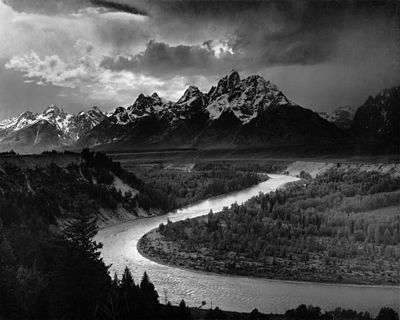Monochrome photography


Monochrome photography is photography where the image produced has a single hue, rather than recording the colors of the object that was photographed. It includes all forms of black-and-white photography, which produce images containing tones of grey ranging from black to white.[1] Other hues besides grey, such as sepia, cyan or brown can also be used in monochrome photography.[2] Monochrome photography is mostly used for artistic reasons in the contemporary world.
Description
Most modern black-and-white films, called panchromatic films, record the entire visible spectrum.[1]:157 Some films are orthochromatic, recording visible light wavelengths shorter than 590 nanometers,[1]:158 in the blue to green range of the spectrum and are less sensitive to the longer wavelength range (i.e. orange-red) of the visible spectrum.[3] Black-and-white photography is considered by some to be more subtle and interpretive, and less realistic than color photography.[1]:5 Monochrome images are not direct renditions of their subjects, but are abstractions from reality, representing colors in shades of grey. In computer terms, this is often called greyscale.[4] Black-and-white photography is considered by some to add a more emotional touch to the subject, compared with the original colored photography.[5]
Sepia and brown hued images are produced by certain photographic processes such as calotypes and albumen prints, or by the use of toning solutions which convert silver in the image to silver sulphide, imparting the brown or sepia tone. Selenium toner produces a blue-black or purple image, similarly by converting silver into more stable silver selenide.[6] Cyanotypes used iron salts rather than silver salts to create blue and white hued images.[2]
Monochrome images may be produced using black-and-white film or paper, or by manipulating color images using computer software. Color images can be converted to black and white on the computer using several methods, including desaturating the existing color RGB image so that no color remains visible (which still allows color channels to be manipulated to alter tones such as darkening a blue sky, or by converting the image to a greyscale version (which eliminates the colors permanently), using software programs like Photoshop.[7] After software conversion to a monochrome image, one or more hues can replace the grey tones to emulate duotones, sepia, selenium or gold toned images or cyanotype, calotype or albumen prints.[2][8]
Gallery
-

Black and white image
-

Digitally toned sepia image
-

Digitally toned cyanotype image
References
- 1 2 3 4 Langford, Michael (2000). Basic Photography (7th ed.). Oxford: Focal Press. ISBN 0-240-51592-7.
- 1 2 3 Lambrecht, Ralph W.; Woodhouse, Chris (2011). Way beyond monochrome: advanced techniques for traditional black & white photography (2nd ed.). Amsterdam: Focal press. ISBN 978-0-240-81625-8.
- ↑ Upton, Barbara London, Jim Stone, John Upton (2008). Photography (9th ed.). Upper Saddle River (N. J.): Pearson Prentice Hall. ISBN 978-0131752016.
- ↑ "Definition: Grayscale". www.techtarget.com. Retrieved 18 November 2014.
- ↑ "Black and White Photographs, January 16, 2015". Retrieved 2015-04-20.
- ↑ Graves, Carson (2000). "Chapter 8 - Toning". Elements of black and white printing (2nd ed.). Oxford: Focal. pp. 100–115. ISBN 978-0240803128.
- ↑ Gibson, Andrew. "7 Black and White Photoshop Conversion Techniques - Envato Tuts+ Photo & Video Tutorial". Photo & Video Envato Tuts+. Archived from the original on 17 January 2016. Retrieved 26 January 2016.
- ↑ Beardsworth, John (2007). Advanced digital black & white photography (1st ed.). New York: Lark Books. ISBN 978-1600592102.
External links
| Wikimedia Commons has media related to Black and white photography. |
- Black and White Film Information and Comparisons Chart